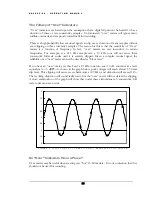
A D 2 4 0 2 - 9 6 - O P E R A T I N G M A N U A L
converters is that all automatic transitions between external and internal clock are silent and will
not interrupt the operation of the A/D converter.
For A/D conversion at non-standard frequencies, use the “Var” (varispeed) setting.
In
varispeed mode, the A/D sample rate is determined by the sample rate of the digital audio input
signal. If no digital input is present, the converter will mute, and the digital outputs will default to
44.1 kHz. The “Var” mode supports any sample rate between 28 and 100 kHz but
does not
have
the jitter immunity provided by the fixed frequency modes. Use fixed frequency mode whenever
possible.
For A/D conversion at high sample-rates using “Single-Cable” interfaces, select either “88.2”
or “96”.
These single-cable 88.2 and 96 kHz settings are labeled in white. These settings are
compatible with high sample-rate recorders that are specifically designed to support single-cable
interfaces.
For A/D conversion at high sample-rates using “Dual-Cable” interfaces, select either “88.2”
“Dual-Cable” or “96” “Dual-Cable”.
These dual-cable 88.2 and 96 kHz settings are labeled in
black. These settings allow high sample-rate recording on 44.1 and 48 kHz recorders. Channel 1
will be directed to the “Main” outputs. Channel 2 will be routed to the “Aux” outputs. Two
tracks will be required for each channel.
Caution: In “Dual Cable” mode, each digital output is dedicated to a single audio
channel instead of a stereo pair. “Dual Cable” recordings require 88.2 and 96 kHz
playback and editing equipment. Furthermore, “Dual Cable” recordings must
always be dubbed and transferred from 44.1 and 48 kHz recorders in the digital
domain. The “Dual Cable” digital output from the recorder must always be mixed,
edited, processed, and converted to analog using 88.2 or 96 kHz equipment.
Label
all “Dual-Cable” recordings carefully!
A 96 kHz “Dual Cable” recording may
appear to play properly at the analog outputs of a 48 kHz machine, but these analog
output signals will actually contain unwanted alias tones that cannot be removed with
a filter.
For Digital to Digital processing, select “D-to-D”.
The “D-to-D” mode provides high-quality
digital to digital processing functions that can be used individually or in combination.
“D-to-D” functions include; word length reduction, SPDIF to AES/EBU format conversion,
AES/EBU to SPDIF format conversion, and SCMS copyright correction. In addition, the
AD2402-96 can act as a 1-in, 4-out digital distribution amplifier.
The digital input will accept either consumer or professional format digital audio. The “Format”
switch always determines the format of all four digital outputs.
14















































